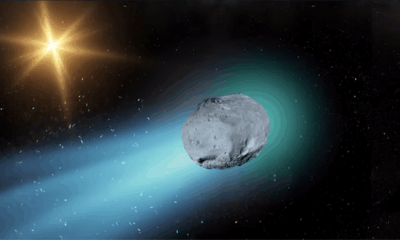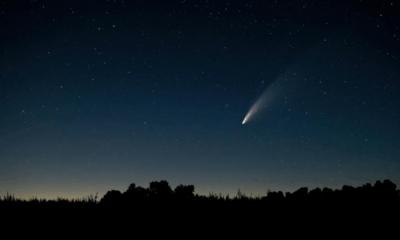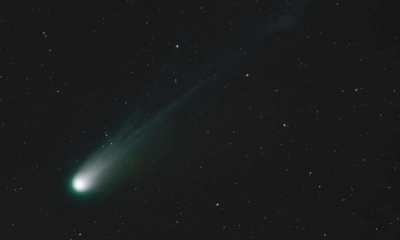Science
NASA Investigates Comet 3I/ATLAS’s Unexpected Color Change

NASA scientists are closely examining the interstellar comet 3I/ATLAS, which is presenting a series of perplexing phenomena that challenge existing knowledge of these celestial bodies. The comet has recently displayed a striking blue hue and an unusual acceleration that cannot be attributed solely to gravitational forces. As new data and images emerge from several space agencies, researchers are racing to unravel the reasons behind this unexpected behavior.
Changing Colors and Accelerating Motion
One of the most intriguing aspects of 3I/ATLAS is its rapidly shifting color palette. Initially observed with red and green tones, the comet has now taken on a distinct bluish tint. This alteration is likely a result of changing gaseous compositions within its coma, the nebulous shell surrounding its nucleus. Gases such as cyanides and dicarbon can emit green light, while carbon monoxide or ammonia might explain the current blue coloration. The transient nature of these color changes, particularly around the comet’s perihelion on October 30, 2023, remains a mystery for scientists.
Adding to the complexity, 3I/ATLAS has shown signs of non-gravitational acceleration. This phenomenon is not unprecedented for comets, as jets of outgassed materials can act similarly to thrusters, propelling the nucleus in unexpected directions. Yet, the degree of this effect in 3I/ATLAS raises questions that require thorough investigation. Given the comet’s interstellar origins and recent spikes in activity, scientists are keen to understand the fundamental nature of this object.
Multinational Observations and Findings
Multiple space agencies are collaborating to monitor 3I/ATLAS, providing critical data from various vantage points. The Tianwen-1 Mars orbiter, operated by China, has captured rare images of the comet from its orbit around Mars. This new perspective complements observations made by the European Space Agency‘s Mars Express and ExoMars probes, contributing to a comprehensive understanding of the comet’s behavior.
As 3I/ATLAS has recently emerged from behind the Sun, Earth-based observations have resumed. The Virtual Telescope Project successfully captured new images on November 5, 2023, marking the start of a season where astronomers can track the comet’s brightness and behavior on a nightly basis.
This interstellar visitor is only the third of its kind ever detected, following 1I/’Oumuamua and 2I/Borisov. It travels on a hyperbolic path, indicating that it will pass close to our Sun before continuing its journey into deep space. Observations during its perihelion revealed that 3I/ATLAS brightened more than anticipated, suggesting unusual outgassing or changes in dust-to-gas dynamics.
Additionally, analyses from the James Webb Space Telescope (JWST) indicate that the comet’s surface may possess a radiation-altered crust up to 20 metres deep, hinting at its exposure to the harsh conditions of interstellar space over billions of years.
As investigations into 3I/ATLAS continue, scientists remain eager to unlock the secrets of this remarkable interstellar object. The findings not only deepen our understanding of comets but also offer insights into the broader dynamics of celestial bodies traversing our solar system.
-

 Entertainment2 months ago
Entertainment2 months agoAnn Ming Reflects on ITV’s ‘I Fought the Law’ Drama
-

 Entertainment3 months ago
Entertainment3 months agoKate Garraway Sells £2 Million Home Amid Financial Struggles
-

 Health2 months ago
Health2 months agoKatie Price Faces New Health Concerns After Cancer Symptoms Resurface
-

 Entertainment2 months ago
Entertainment2 months agoCoronation Street’s Carl Webster Faces Trouble with New Affairs
-

 Entertainment2 months ago
Entertainment2 months agoWhere is Tinder Swindler Simon Leviev? Latest Updates Revealed
-

 Entertainment3 months ago
Entertainment3 months agoKim Cattrall Posts Cryptic Message After HBO’s Sequel Cancellation
-

 Science3 weeks ago
Science3 weeks agoBrian Cox Addresses Claims of Alien Probe in 3I/ATLAS Discovery
-

 Entertainment2 months ago
Entertainment2 months agoOlivia Attwood Opens Up About Fallout with Former Best Friend
-

 Entertainment3 months ago
Entertainment3 months agoMarkiplier Addresses AI Controversy During Livestream Response
-

 Entertainment3 months ago
Entertainment3 months agoMasterChef Faces Turmoil as Tom Kerridge Withdraws from Hosting Role
-

 Entertainment4 months ago
Entertainment4 months agoSpeculation Surrounds Home and Away as Cast Departures Mount
-

 World2 months ago
World2 months agoCole Palmer’s Mysterious Message to Kobbie Mainoo Sparks Speculation





















